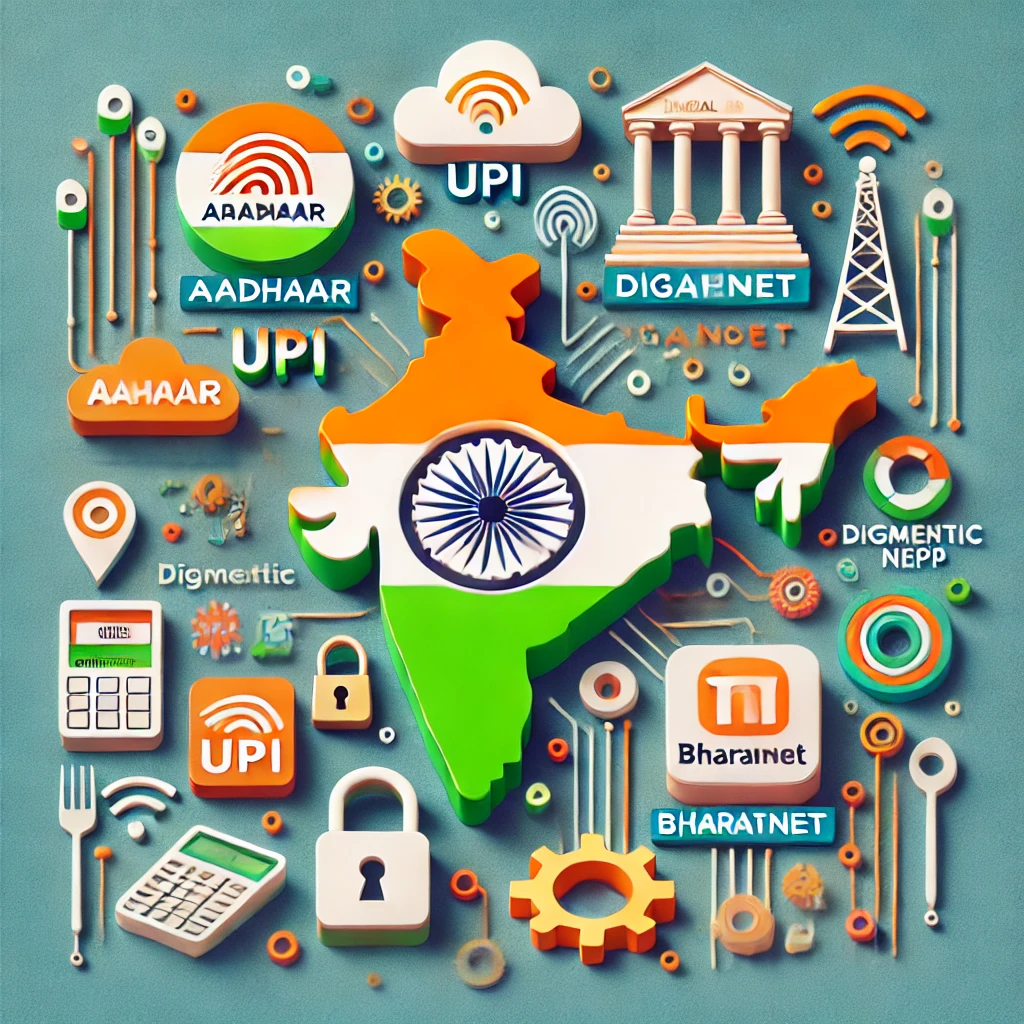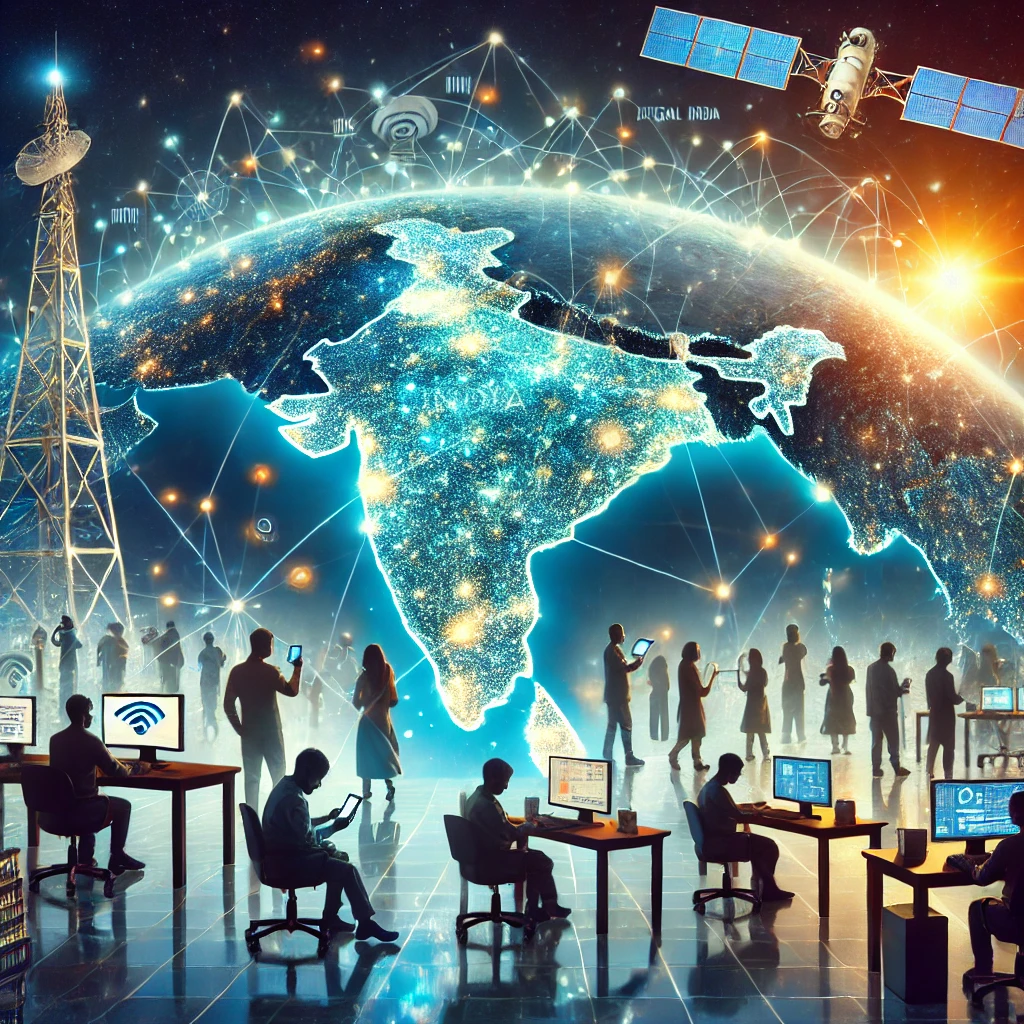 Introduction of Digital India Mission
Introduction of Digital India Mission
Overview of the Digital India Mission
Digital India Mission is a flagship initiative by the Government of India aimed at transforming the country into a digitally empowered society and knowledge economy. This ambitious program focuses on improving digital infrastructure, increasing internet accessibility, and promoting online governance services. By leveraging technology, Digital India seeks to bridge the gap between urban and rural areas and ensure that every citizen has access to digital resources.
When and Why It Was Launched
Digital India was officially launched on 1st July 2015 by Prime Minister Narendra Modi. The primary reason behind this initiative was to enhance digital connectivity, promote e-governance, and reduce dependency on paper-based transactions. Before this, India faced significant challenges such as limited internet penetration, slow digitization of services, and low digital literacy rates—especially in rural areas. This mission aimed to address these issues and bring India to the forefront of the global digital revolution.
The Vision Behind the Initiative
The core vision of Digital India revolves around three key areas:


With these objectives, the Digital India Mission is not just about technology; it’s about empowering people and businesses through digital transformation.
 Objectives of the Digital India Mission
Objectives of the Digital India Mission
 Bridging the Digital Divide
Bridging the Digital Divide
One of the biggest challenges in India is the gap between digitally connected and unconnected citizens. The mission aims to:


 Empowering Citizens Through Technology
Empowering Citizens Through Technology
Technology should be an equalizer, not a divider. Digital India ensures that everyone, regardless of background or location, can access government services, education, and financial tools digitally. Initiatives like DigiLocker, e-Hospitals, and e-Governance portals have made life easier for millions.
 Strengthening Digital Infrastructure
Strengthening Digital Infrastructure
To make Digital India a reality, strong digital infrastructure is needed. This includes:


 Key Pillars of Digital India
Key Pillars of Digital India
To achieve its objectives, the Digital India Mission is built on five major pillars:
 Broadband Highways
Broadband Highways
The foundation of Digital India is fast and reliable internet connectivity. The government launched BharatNet to connect 2.5 lakh Gram Panchayats (village councils) with high-speed broadband. This initiative has helped improve access to education, healthcare, and online services.
 Universal Mobile Connectivity
Universal Mobile Connectivity




 Public Internet Access Programs
Public Internet Access Programs
To make digital services more accessible, the government has set up Common Service Centers (CSCs) across the country. These centers provide:


 E-Governance Initiatives
E-Governance Initiatives
The government has digitized public services to make them more transparent and efficient. Some key initiatives include:


 Digital Literacy Programs
Digital Literacy Programs
To ensure that people can use digital services effectively, the government launched the Pradhan Mantri Gramin Digital Saksharta Abhiyan (PMGDISHA). This initiative aims to make at least 6 crore rural citizens digitally literate, helping them navigate online platforms confidently.
 Major Initiatives Under Digital India
Major Initiatives Under Digital India
 Aadhaar: The Backbone of Digital Identity
Aadhaar: The Backbone of Digital Identity
Aadhaar has revolutionized India’s identification system, providing a unique 12-digit biometric-based identity to over 1.3 billion Indians. It serves as a foundation for various digital services, including:


 BharatNet: Expanding Internet Connectivity
BharatNet: Expanding Internet Connectivity
BharatNet is one of the world’s largest rural broadband projects, aiming to provide high-speed internet access to 2.5 lakh Gram Panchayats (villages). This initiative helps in:


 DigiLocker: Secure Document Storage
DigiLocker: Secure Document Storage
DigiLocker is a cloud-based digital document storage system, where citizens can securely store and access important documents like:



It eliminates the need for physical copies and makes government document verification hassle-free.
 UMANG App: One-Stop Platform for Government Services
UMANG App: One-Stop Platform for Government Services
UMANG (Unified Mobile Application for New-age Governance) is a single platform that provides access to 1,200+ government services, including:



 Jan Dhan-Aadhaar-Mobile (JAM) Trinity
Jan Dhan-Aadhaar-Mobile (JAM) Trinity
The JAM Trinity is a game-changer in financial inclusion, linking:


This system has helped in direct benefit transfers, reducing corruption and increasing transparency in government schemes.
 Role of Digital Payments and Fintech in Digital India
Role of Digital Payments and Fintech in Digital India
 UPI: The Revolution in Digital Transactions
UPI: The Revolution in Digital Transactions
The Unified Payments Interface (UPI) has completely transformed India’s digital economy. With over 10 billion transactions per month, UPI enables:


 Growth of Digital Wallets and Banking Apps
Growth of Digital Wallets and Banking Apps
Apart from UPI, digital wallets like Paytm, Mobikwik, and Amazon Pay have made transactions cashless and effortless. Features include:


 Impact on Financial Inclusion
Impact on Financial Inclusion
Digital payments have empowered rural and unbanked populations by:


 E-Governance and Online Services
E-Governance and Online Services
 Paperless Governance: A Step Towards Transparency
Paperless Governance: A Step Towards Transparency
E-Governance has replaced traditional bureaucratic hurdles with digital solutions:


 Digital Platforms for Public Services
Digital Platforms for Public Services
Some of the most popular platforms under Digital India include:


 E-Courts and Digital Judiciary
E-Courts and Digital Judiciary
The government has introduced e-Courts, enabling:


 Digital India’s Impact on Education and Healthcare
Digital India’s Impact on Education and Healthcare
 Online Education Platforms and Digital Classrooms
Online Education Platforms and Digital Classrooms
With the rise of online learning, platforms like DIKSHA, Swayam, and e-Pathshala provide:


 Ayushman Bharat Digital Mission: Transforming Healthcare Access
Ayushman Bharat Digital Mission: Transforming Healthcare Access
This initiative aims to digitize healthcare records and services, ensuring:


 Role of AI and Telemedicine in Digital Healthcare
Role of AI and Telemedicine in Digital Healthcare
AI and telemedicine are bridging the healthcare gap in India by:



 Digital India and Employment Opportunities
Digital India and Employment Opportunities
 Rise of IT and Digital Startups
Rise of IT and Digital Startups
India has emerged as a global hub for startups due to Digital India’s initiatives. Benefits include:


 Growth of the Gig Economy
Growth of the Gig Economy
Freelancing and remote jobs have skyrocketed, with platforms like:


 Skill Development Programs
Skill Development Programs
To equip youth with digital skills, the government launched:


 Challenges and Roadblocks in Implementation
Challenges and Roadblocks in Implementation
Despite its massive success, the Digital India Mission faces several challenges that slow down its progress. Here are some major roadblocks:
 Internet Connectivity in Rural Areas
Internet Connectivity in Rural Areas








 Digital Literacy Gaps
Digital Literacy Gaps








 Cybersecurity and Data Privacy Concerns
Cybersecurity and Data Privacy Concerns








 Government’s Future Plans for Digital India
Government’s Future Plans for Digital India
 5G Technology and Its Impact
5G Technology and Its Impact
5G technology is expected to revolutionize India’s digital landscape by:





 Expanding AI and Machine Learning Applications
Expanding AI and Machine Learning Applications
The government is actively working on integrating Artificial Intelligence (AI) and Machine Learning (ML) in various sectors:



 Strengthening Data Protection Laws
Strengthening Data Protection Laws
To ensure data privacy and cybersecurity, the government is working on:



 Conclusion
Conclusion
The Digital India Mission has transformed India into a tech-driven nation, creating:



With 5G, AI, and cybersecurity advancements, India is on track to becoming a global digital leader. However, public participation is crucial – every citizen must embrace digital literacy and responsible internet usage.


 FAQs
FAQs
1. What is the main goal of the Digital India Mission?
The main goal is to make India digitally empowered, providing internet access, online governance, and financial inclusion for all citizens.
2. How has Digital India improved online transactions?
Initiatives like UPI, digital wallets, and Aadhaar-linked banking have made cashless payments faster, safer, and more accessible, reducing dependency on cash.
3. What are some key e-governance initiatives under Digital India?



4. How does Digital India benefit rural areas?



5. What are the challenges faced by Digital India?




Tamim is a distinguished policy analyst with over 15 years of experience in analyzing, government schemes and policies. Tamim brings a wealth of knowledge and expertise in the field of social development.
